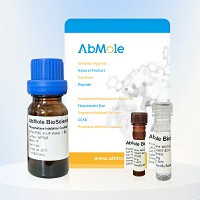All AbMole products are for research use only, cannot be used for human consumption.

Species: Mouse/Rat
Expression system: Mammalian
Purity: > 95% as determined by reduced SDS-PAGE
Endotoxin: less than 0.001 ng/µg (0.01 EU/µg)
Molecular weight: 12.8 KDa
Lyophilized from a 0.2 μm filtered solution of 4mM HCl.
Storage and stability: The freeze-dried protein should be stored at ≤-20℃ and stored stably for one year after receiving. The recombinant protein solution can be stored at 2-8℃ for 2-7 days. The recombinant samples were stabilized at ≤-20°C for 3 months.Measured by its ability to inhibit IL-4-dependent proliferation of TF‑1 human erythroleukemic cells, the ED50 for this effect is 5-25 pg/ml.
Biological activity: Transforming growth factor β1 (TGFβ1) is the prototype of the growth superfamily of peptide growth factors, which plays an important role in a variety of cellular processes including cell cycle progression, cell differentiation, reproductive function, development, motility, adhesion, neuronal growth, bone morphogenesis, wound healing and immune monitoring. TGF-β1, TGF-β2, and TGF-β3 signals are transmitted through the same heteromer receptor complex consisting of ligands that bind to TGF-βreceptor type II (TβR-II) and TGF-βI (TβR-I). Signal transduction from receptor to nucleus is mediated by SMADs. TGF-β is expressed in cartilage, bone, teeth, muscle, heart, blood vessels, hematopoietic cells, lungs, kidneys, intestines, liver, eyes, ears, skin and nervous system.

Biol Pharm Bull. 2024 Oct 30;47(10):1774-1785.
5-Demethylnobiletin Ameliorates Isoproterenol-Induced Cardiac Fibrosis and Apoptosis by Repressing the Sirt1/FOXO3a/NF-κB and Wnt/β-Catenin Pathways
Recombinant Mouse/Rat TGF-beta 1 (HEK293) purchased from AbMole
| Solubility (25°C) | Dissolve the lyophilized protein in 4mM HCl. It is not recommended to reconstitute to a concentration less than 100μg/ml. |
| Storage | Stored at ≤ -20°C, stable for one year after receipt. |
| Related Cytokines and Growth Factors Products |
|---|
| Recombinant Human GDF-15 Protein (HEK293 N-hFc)
Growth-differentiation factor 15 (GDF15), also known as MIC-1, is a secreted member of the transforming growth factor (TGF)-β superfamily. GDF-15 has a role in regulating inflammatory and apoptotic pathways in injured tissues and during disease processes. GDF-15 overexpression arising from an expanded erythroid compartment contributes to iron overload in thalassemia syndromes by inhibiting hepcidin expression. |
| Recombinant Human FGFR1 Protein (HEK293, C-His)
FGFR1, also known as CD331, is a full-length representative protein consists of an extracellular region, composed of three immunoglobulin-like domains, a single hydrophobic membrane-spanning segment and a cytoplasmic tyrosine kinase domain. |
| Recombinant Human FGFR2 Protein (HEK293, C-His)
FGFR2, also known as CD332, acts as cell-surface receptor for fibroblast growth factors and plays an essential role in the regulation of cell proliferation, differentiation, migration and apoptosis, and in the regulation of embryonic development. FGFR2 plays an essential role in the regulation of osteoblast differentiation, proliferation and apoptosis, and is required for normal skeleton development. It also promotes cell proliferation in keratinocytes and imature osteoblasts, but promotes apoptosis in differentiated osteoblasts. |
| Recombinant Mouse BMP-4 Protein (E. coli, C-His)
Bone Morphogenetic Protein-4 (BMP-4) is a critical signaling molecule required for the early differentiation of the embryo and establishing of a dorsal-ventral axis. BMP-4 is secreted from the dorsal portion of the notochord, and it acts in concert with sonic hedgehog to establish a dorsal-ventral axis for the differentiation of later structures. |
| Recombinant Human Coagulation Factor X (HEK293, C-Fc)
Coagulation factor X, belongs to the peptidase S1 family. Coagulation factor X is initially synthesized in the liver. Coagulation factor X is a vitamin K-dependent glycoprotein that converts prothrombin to thrombin in the presence of factor Va, calcium and phospholipid during blood clotting. |
All AbMole products are for research use only, cannot be used for human consumption or veterinary use. We do not provide products or services to individuals. Please comply with the intended use and do not use AbMole products for any other purpose.


Products are for research use only. Not for human use. We do not sell to patients.
© Copyright 2010-2024 AbMole BioScience. All Rights Reserved.
